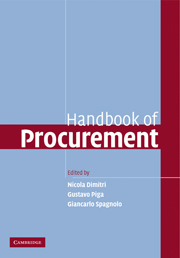Book contents
- Frontmatter
- Contents
- List of figures
- List of tables
- List of contributors
- Preface
- Part I Preliminary Issues
- Part II General Strategic Principles
- Part III Competitive Tendering Strategies
- Part IV Attracting and Screening Participants
- Part V Preventing Collusion and Corruption
- Part VI Dynamic Forces and Innovation
- 17 Managing dynamic procurements
- 18 Designing reputation mechanisms
- 19 Procuring innovations
- Glossary
- Index
- References
18 - Designing reputation mechanisms
Published online by Cambridge University Press: 04 November 2009
- Frontmatter
- Contents
- List of figures
- List of tables
- List of contributors
- Preface
- Part I Preliminary Issues
- Part II General Strategic Principles
- Part III Competitive Tendering Strategies
- Part IV Attracting and Screening Participants
- Part V Preventing Collusion and Corruption
- Part VI Dynamic Forces and Innovation
- 17 Managing dynamic procurements
- 18 Designing reputation mechanisms
- 19 Procuring innovations
- Glossary
- Index
- References
Summary
Introduction
A common problem in procurement is the presence of relevant aspects of an exchange that cannot be fully specified in an explicit contract, because for example they are not verifiable by a third party (like a court or an arbitrator) at reasonable cost. Non-contractibility opens the door to two well-known forms of opportunism: ‘ex-ante’ and ‘post-contracting’ opportunism. Ex-ante opportunism takes place at the supplier selection stage, when the valuation of a good or service by the buyer depends on some unobservable characteristics of the seller or the good/service it provides. This often results in an undesirable matching between buyers and sellers, that is, in situations where a buyer may end up interacting with a seller (or buying a good) that does not have the desired characteristics (e.g., quality), even though sellers (goods) with the desired characteristics are present in the market. Post-contracting opportunism refers to possible opportunistic behaviour of one trading party during the procurement transaction that reduces the welfare of the other; for example, a contractor or a seller who, after having been selected, reduces below the level agreed upon the quality of service (or the effort exerted) on those aspects of the supplied good/service that are difficult or costly to monitor.
Appropriate explicit incentive contracts can partly overcome these informational problems when indicators correlated to the non-contractible features exist. Procured goods and services often present important qualitative aspects that are difficult to specify and enforce contractually and buyers have limited contractual tools to control opportunism.
- Type
- Chapter
- Information
- Handbook of Procurement , pp. 446 - 482Publisher: Cambridge University PressPrint publication year: 2006
References
- 26
- Cited by



